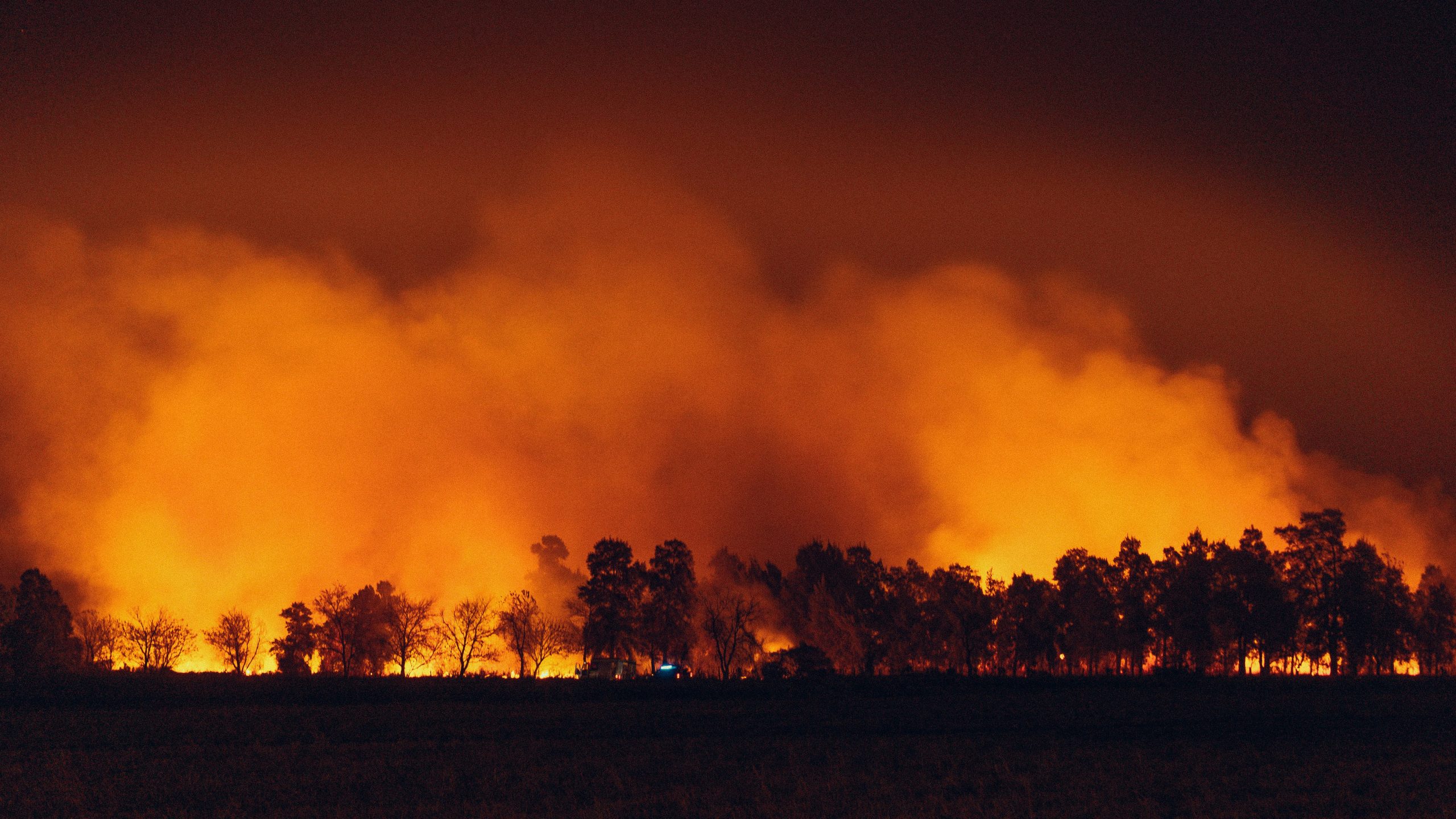As climate change drives record-breaking wildfires worldwide, wildfire management policies are more important than ever. Photo credit: Fachy Marín via Unsplash
We have seen more than 300 million hectares of land burned globally this year due to wildfires. The UK alone has seen over 996 wildfire incidents this year—a fourfold increase compared to 2024. Hot, dry, and windy conditions turn vegetation into tinder, and climate change is intensifying these weather patterns, increasing the frequency and severity of wildfire harm to ecosystems and communities. This article examines our evolving relationship with wildfires by reviewing research linking climate change to increased wildfire risk, assessing the response to wildfire incidents in Los Angeles, South Korea, and the UK, and considering how wildfire management policy solutions should be implemented.
The UK alone has seen over 996 wildfire incidents this year—a fourfold increase compared to 2024.
According to the United Nations Office for Disaster Risk Reduction (UNDRR), wildfire is defined as any unplanned and uncontrolled vegetation fire that, regardless of ignition source, may negatively affect social, economic, or environmental values. The link between wildfires and climate change has been well established since Flannigan and Van Wagner’s 1991 paper, ‘Climate Change and Wildfire in Canada’. Climate change is widely recognised as one of the four pillars that influence fire activity, the others being fuels, ignition agents, and human activity. Furthermore, General Circulation Models (similar to weather forecasts) project that high-latitude regions will warm more rapidly and receive less precipitation, leading to longer fire seasons, higher ignition probabilities, and more flammable vegetation. Climate change is also shifting the geography of wildfires, exposing historically low-risk regions to greater environmental and human loss.
Since 1979, the global wildfire season has lengthened by 27%, and fire frequency has increased by 54%. Scientists can directly link changes in climate variables to wildfire probability using the Hot-Dry-Windy Index (HDWI), which was developed by Srock et al. The HDWI quantifies the worst possible fire-favouring conditions using vapour-pressure deficit, the difference between measured and potential air moisture (hot-dry), and wind speed (windy). Vapour-pressure deficit is a key indicator of wildfire risk due to its direct link with vegetation dryness and a higher ignition probability. High wind speeds enable wildfires to spread more quickly, further increasing wildfire risk. Therefore, the HDWI index is an important measure used in climate studies of wildfire events.
Turning from research to ecological impact, wildfires cause both immediate and secondary environmental harm. Vegetation loss from wildfire leaves the soil vulnerable to erosion from heavy rainfall and increases susceptibility to landslides. Vegetation recovery can often take years, as was the case in the Pomares and Piódão regions in Portugal, where flash floods led to particularly severe landslides in 2006 because of wildfires in the same area in 1987.
In addition to damage to ecosystems, wildfires harm human health. The World Health Organisation states that fine particulate matter from wildfire smoke (PM2.5) ‘can cause and exacerbate diseases of the lungs, heart, brain/nervous system, skin, gut, kidney, eyes, nose, and liver’. The 2019–2020 Australian bushfires caused an estimated 429 smoke-related premature deaths, 3,230 hospital admissions for cardiovascular and respiratory disorders, and 1,523 emergency attendances for asthma, demonstrating how wildfire smoke can seriously affect healthcare systems.
The ash and debris from wildfires also contaminate water systems, polluting human water supplies and harming wildlife. For example, after the 2017 Tubbs and 2018 Camp Fires in California, volatile organic compounds such as benzene were found at dangerously high levels in drinking water as a result of damaged plastic pipes from the fire. These compounds can damage the liver, kidneys, and central nervous system of both wildlife and humans.
Historically, wildfire has not always been perceived as destructive. Wildfires are a natural phenomenon and have been used as a land-management tool for millennia. Evidence from Tasmania shows humans were using wildfire as early as 41,600 years ago, where early inhabitants cleared forest cover and helped certain types of plants to grow using wildfire. Humans have long shaped landscapes with fire, suggesting that we should seek strategies that balance suppression with controlled ecological use of fire.
Evidence from Tasmania shows humans were using wildfire as early as 41,600 years ago…
Today, indigenous communities such as the Monkoxɨ people in Bolivia and the Tsa’tinne in Alberta use controlled wildfire to enrich soils, sustain biodiversity, and limit the build-up of flammable vegetation. In Bolivia, when authorities banned traditional burning after wildfires in 2019, the Union of Indigenous Communities (CICOL) negotiated a self-governed fire strategy of seasonal burn protocols and forest monitoring. In Alberta, similar low-intensity burns keep berry patches productive, maintain caribou habitats, and create natural breaks that slow dangerous, unmanaged wildfires. As Sara Wickham noted on behalf of the World Economic Forum, ‘Indigenous fire stewardship blends intergenerational knowledge, beliefs, and values’, reframing wildfire management to focus on coexistence and prevention rather than reactive suppression. Indigenous fire practices demonstrate that planned, low-intensity burns can prevent catastrophic wildfires, promote biodiversity, and maintain productive landscapes.
With this scientific and cultural context in mind, I will assess three case studies: Los Angeles, South Korea, and the UK. These examples demonstrate that climate change is increasing wildfire risk, that technology and policy are important for managing wildfire, and cooperation between different levels of government is essential to the successful implementation of wildfire policy.
Los Angeles, US
In January 2025, the Los Angeles wildfires burned 40,000 acres, destroyed thousands of structures, and killed 27 people, according to the Los Angeles County Report. The World Weather Attribution group found climate change made the event 35% more likely, as calculated by the HWDI index. This high risk was driven by exceptional Santa Ana winds and above-average precipitation in previous years. It may seem counterintuitive, but above-average precipitation is problematic because it stimulates vegetation growth, which later dries out to become abundant fuel, heightening the risk of severe wildfires.
Financial losses totalled $250 billion, the greatest cost of any US natural disaster, according to the Los Angeles Times. While immediate media coverage focused on wealthy neighbourhoods, Latino communities were disproportionately affected due to pre-existing inequalities, such as greater air pollution exposure, higher outdoor-work rates, and lower healthcare access. Expansion of the wildland-urban interface (where people live close to wild vegetated areas) has further increased community exposure to wildfire. The LA fires highlight the need for stronger US wildfire preparation to address deepening inequalities, as well as mitigate climate hazards.
These concerns were underscored by the freeze on federal funding for wildfire management programmes.
These impacts highlight how federal and state decisions affect the risk of ecological and social harm from wildfires. California Governor Gavin Newsom criticised President Trump for diverting National Guard personnel from wildfire prevention and response during protests against immigration raids and deportations. These concerns were underscored by the freeze on federal funding for wildfire management programmes. This freeze included the $20 million Hazardous Fuels Transportation Assistance programme, which removes dead wood from forests, a key measure to reduce fire risk. In response, President Trump issued an executive order on 12 June aimed at ‘empowering common sense wildfire prevention and response’, establishing a technology roadmap to use AI and enhanced data sharing for risk-informed wildfire management. This would integrate satellite monitoring, predictive wildfire modelling, and real-time fire data to anticipate high-risk areas and optimise responses to wildfire. However, simultaneous staff reductions in the National Guard firefighting unit appear to conflict with these ambitions. State and federal governments need to lead together on future wildfire response.
South Korea
South Korea faces similar challenges to the US in protecting highly flammable landscapes and vulnerable populations. This highlights the global requirement for effective wildfire management and international collaboration.
In March 2025, South Korea experienced its worst wildfire on record, with over 23,000 people needing to be evacuated to safety. Fires burned over 48,000 hectares of land, more than ten times the national annual average burnt area. Pine forests dominate the affected areas and are particularly vulnerable to wildfire because of their high resin content, which acts like oil to increase the flammability of the wood. Pine forests also support crown fires, where tree canopies carry fires quickly because pine don’t lose their leaves in winter.
Examining this event, the World Weather Attribution group reported a 25% increase in intensity of the HDWI for March compared to a pre-industrial climate, and a doubling in the likelihood of wildfire events due to climate change. South Korea’s forests have been heavily reforested since the 1970s, following severe depletion during the Korean War and Japanese occupation. Reforestation has slowed soil erosion and restored biodiversity, but a denser wildland-urban interface has increased wildfire risk as humans are the primary cause of wildfire ignition. This raises a key policy trade-off: balancing the ecological benefits of trees with the heightened fire risk they can pose under climate change.
…key policy trade-off: balancing the ecological benefits of trees with the heightened fire risk they can pose under climate change.
Addressing these policy gaps increasingly depends on the strategic use of technology to anticipate, prevent, and respond to wildfires. Research by Kim and Kang has highlighted key gaps in South Korea’s wildfire policy, including ‘an over-reliance on seasonal caution…, limited public risk awareness…, and post-fire recovery methods that do not fully account for the prolonged recovery needed of severely impacted ecosystems’. Like the USA’s ambitions to use AI for risk-informed wildfire management, South Korea is integrating AI drones, predictive modelling, and real-time monitoring that could transform wildfire management from reactive recovery methods to proactive ecosystem protection, reducing both ecological and social harm. Our relationship with wildfire is evolving to be research and technology-led.
UK
Rising average temperatures and a changing climate are also creating challenges for the UK, where wildfire risk is rapidly increasing. The UK, too, will need to look to technology to reshape wildfire management, as in the US and South Korea.
In 2018, during a two-week-long heatwave, the UK became the country with the third-largest burnt area in Europe. This year, we have already exceeded 45,000 hectares burned from wildfires, driven by two July heatwaves with temperatures sustained above 30 °C. While we may have enjoyed the scorching summer weather, this year’s heat is becoming a more regular occurrence due to climate change. As Brigitte Nerlich of the University of Nottingham observed, ‘wildfires are not just burning heather and gorse’, they are challenging public perceptions of the UK’s vulnerabilities to climate change.
Addressing this challenge will require technological innovation. As highlighted in the US and South Korea, public education, prescribed burn management, and the use of new technology can combine into effective wildfire resilience plans. The UK is starting to integrate technology into wildfire management through initiatives such as the National Trust’s AI wildfire sensors and the FireUp monitoring system in the Peak District. These systems detect fires by measuring air quality and smoke levels, enabling rapid alerts when wildfires start. Nevertheless, effective management ultimately depends on government strategy and human response teams.
Compared with the more centralised wildfire strategies in the US and South Korea, the UK has relied on a devolved approach, with wildfire receiving limited national attention until it was added to the National Risk Register in 2013. The UK lacks a dedicated wildfire firefighting force, relying instead on local Fire and Rescue Services with limited specialist training for rural wildfires. To improve resilience, the UK should draw on lessons from the US and South Korea to manage wildfires in a changing climate.
Policy Implications
The international stage is an important platform for sharing and discussing responses to wildfires. The Organisation for Economic Co-operation and Development’s (OECD) 2023 report highlighted the often irreversible damage wildfires cause to ecosystems, such as the 2017 Chile wildfires, which damaged nearly 40% of critically endangered habitats. The report identified three principal strategies that reduce wildfire risk: improving forest management, adapting urban environments, and increasing the scale of management. For the UK, improving and scaling management might include more firebreaks and buffer zones, stopping illegal and unsustainable land use, and centralising wildfire response coordination and knowledge exchange (for example, a service similar to Portugal’s Agency for Integrated Management of Rural Fires).
Climate change is lengthening wildfire seasons and intensifying fire severity, particularly at high latitudes (closer to the poles), even though the overall global area burned has decreased slightly due to fewer fire events in savannah and grassland regions. Nevertheless, climate change is intensifying fires in ecosystems that are not adapted to frequent burning, amplifying ecological and social damage.
So, what are the solutions? To answer this, we must first think more carefully about who will be involved in these solutions.
- Management of wildfire must include a combination of technology-led
information gathering and assessment specialists, coupled with local and
national policymakers and implementers. - Local and indigenous communities’ knowledge and relationship with
wildfire must also be included in the solution, in both prevention and
response strategies. - Governments must shift from a “suppress all fires” mindset to recognising
wildfire as a natural process: Without controlled burns, the risk of severe
and uncontrolled wildfire worsens. - Ecosystems must be protected, as case studies from Los Angeles, South
Korea, and the UK show that the complex interactions of land use changes
and wildland-urban pressures are harming both communities and
nature. - Equally important to what the solutions are is how they should be
implemented, at the national or local level, involving national and local
response teams.
It is important for governments, citizens, and scientists to carefully consider how our future relationship with wildfire should evolve.
All these perspectives need to be included in order to safeguard ecosystems and communities. The year 2025 has dramatically shaped our relationship with wildfire. It is important for governments, citizens, and scientists to carefully consider how our future relationship with wildfire should evolve.





